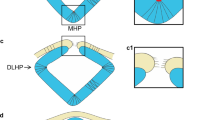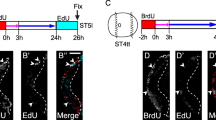Abstract
We have studied the process of neurulation within the anterior trunk region of the zebrafish by means of serial sectioning of staged embryos and labelling cells by applications of the dye Dil and intracellular injections of fluoresceine dextran amine. The first morphological manifestation of the prospective neural plate is a dorsomedial ectodermal thickening which becomes visible immediately after gastrulation. Within 1–2 h, by the time somatogenesis begins, two bilaterally symmetrical thickenings have appeared more laterally, which eventually fuse with the medial thickening to form the neural keel. The central canal forms next by separation of the cells on either side of the midline of the neural keel, beginning ventrally at the 17-somite stage and progressing towards dorsal levels. By means of fluorescent dye labelling in the late gastrula, we found that both the medial and lateral thickenings contribute to the nerve cord. The medial thickening was found to contain, exclusively, neural progenitor cells from the 90–100% epiboly stage on, whereas the adjacent regions contained a mixture of neural and epidermal progenitor cells, as well as prospective neural crest cells. Between the 90–100% epiboly and 2-somite stages, this heterogeneity of developmental capabilities is resolved into territories, with epidermogenic and neurogenic cells clearly separated from each other. To achieve this segregation into neural and epidermal anlagen, cells from the lateral thickenings have to move over a distance of roughly 400 μm within 1–2 h. Epidermal overgrowth of the nerve cord occurs during the morphogenetic movements that accompany nerve cord formation.
Similar content being viewed by others
References
Albers B (1987) Competence as the main factor determining the size of the neural plate. Dev Growth Differ 29 (5):535–545
Brun RB, Garson JA (1983) Neurulation in the Mexican salamander (Ambystoma mexicanum): a drug study and cell shape analysis of the epidermis and the neural plate. J Embryol Exp Morphol 74:275–295
Fleig R (1990) Gastrulation in the zebrafish Brachydanio rerio (Teleostei) as seen in the scanning electron microscope. In: Marthy H-J (ed) Experimental embryology in aquatic plants and animals. Plenum Press, New York, pp 329–338
Franke WW, Krien S, Brown RM Jr (1969) Simultaneous glutaraldehyde-osmium tetroxide fixation with postosmification. Histochemie 19:162–164
Goette A (1874) Über die Entwicklung des Zentralnervensystems der Teleostier. Arch Microsk Anat Entwicklungsmech 15:139–200
Hisaoka KK, Battle HI (1958) The normal developmental stages of the zebrafish, Brachydanio rerio (Hamilton-Buchanan). J Morphol 102:311–328
Hisaoka KK, Firlit CF (1960) Further studies on the embryonic development of the zebrafish, Brachydanio rerio (Hamilton-Buchanan). J Morphol 107:205–255
Honig MG, Hume RI (1986) Fluorescent carbocyanine dyes allow living neurons of identified origin to be studied in long-term cultures. J Cell Biol 103:171–187
Hughes AF, Freeman RB (1974) Comparative remarks on the development of the tail cord among higher vertebrates. J Embryol Exp Morphol 32(2):355–363
Karfunkel P (1974) The mechanisms of neural tube formation. Int Rev Cytol 38:245–271
Kimmel CB, Warga RM, Schilling TF (1990) Origin and organization of the zebrafish fate map. Development 108:581–594
Lewis WH (1947) Mechanics of invagination. Anat Rec 97:139–156
Martins-Green M (1988) Origin of the dorsal surface of the neural tube by progressive delamination of epidermal ectoderm and neuroepithelium: implications for neurulation and neural tube defects. Development 103:687–706
Moury JD, Jacobson AG (1989) Neural fold formation at newly created boundaries between neural plate and epidermis in the axototl. Dev Biol 133:44–57
Moury JD, Jacobson AG (1990) The origin of neural crest cells in the axolotl. Dev Biol 141:243–253
Reynolds ES (1963) The use of lead citrate at high pH as an electron-opaque stain in electronmicroscopy. J Cell Biol 17:208–212
Robertis EM de, Oliver G, Wright CVE (1989) Determination of axial polarity in the vertebrate embryo: homeodomain proteins and homeogenetic induction. Cell 57:189–191
Sauer FC (1935) Mitoses in the neural tube. J Comp Neurol 62:377–405
Saxen L, Toivonen S (1961) Embryonic induction. Prentice Hall Englewood Cliffs, New Jersey
Schoenwolf GC, Alvarez IS (1991) Specification of neuroepithelium and surface epithelium in avian transplantation chimeras. Development 112:713–722
Schoenwolf GC, Delongo J (1980) Ultrastructure of secondary neurulation in the chick embryo. Am J Anat 158:43–63
Schoenwolf GC, Sheard P (1990) Fate mapping the avian epiblast with focal injections of a fluorescent-histochemical marker: ectodermal derivaties. J Exp Zool 225:323–339
Schoenwolf GC, Smith JL (1990) Mechanisms of neurulation: traditional viewpoint and recent advances. Development 109:243–270
Schroeder TE (1970) Neurulation in Xenopus laevis. An analysis and model based upon light and electron microscopy. J Embryol Exp Morphol 23(2):427–462
Warga RM, Kimmel CB (1990) Cell movements during epiboly and gastrulation in zebrafish. Development 108:569–580
Waterman RE, McCarty TA (1977) SEM observations of the developing teleost central nervous system. Scanning Electron Microsc 2:387–394
Westerfield M (1989) The zebrafish book. Oregon Press
Author information
Authors and Affiliations
Additional information
Correspondence to: J.A. Campos-Ortega
Rights and permissions
About this article
Cite this article
Schmitz, B., Papan, C. & Campos-Ortega, J.A. Neurulation in the anterior trunk region of the zebrafish Brachydanio rerio . Roux's Arch Dev Biol 202, 250–259 (1993). https://doi.org/10.1007/BF00363214
Received:
Accepted:
Issue Date:
DOI: https://doi.org/10.1007/BF00363214




